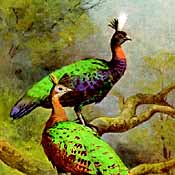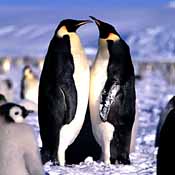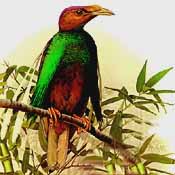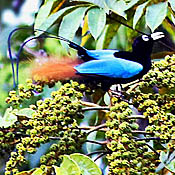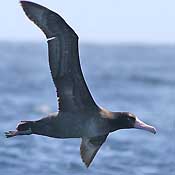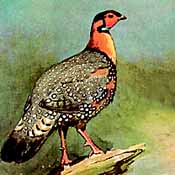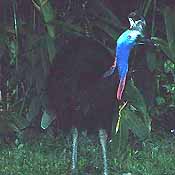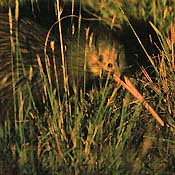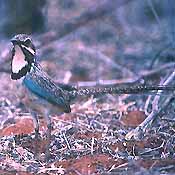# |
Species [range] |
Photo/art [see credits];
all photos taken in the wild |
Summary of reasons for this choice |
DR seen? |
11 |
Congo Peafowl
Afropavo congoensis
[central Africa] |
|
Someone with enough time and money might be able to find any other bird on this page on a bird tour, but until very recently you couldn't "buy" a look at a Congo Peafowl. Only recently have Western researchers seen any in the wild, and only in 2015 was a female seen on a bird tour. That was in Lomako-Yokokala Reserve in the Republic of Congo. Almost nothing is known of its behavior. This has widely been considered the most elusive bird on earth. |
No |
12 |
Emperor Penguin
Aptenodytes forsteri
[Antarctica] |
|
This is the world's largest penguin. As it breeds in the Antarctic winter well inland on that foreboding continent, and far from touristy spots in the ice & snow, few observers see adult birds. Younger Emperors wander more and are seen on some Antarctic cruises. It still has a reasonably healthy population but its huge size and unique life history warrant it a spot well up the list of the earth's great birds. |
No |
13 |
Wallace's Standardwing
Semioptera wallacii
[Halmahera I., Indonesia] |
|
Named for the pioneering naturalist and co-author of the theory of evolution Alfred Russell Wallace, this unusual bird-of-paradise is restricted to lowland forests on Halmahera and Bacan, northern Moluccas. Males display in lekking trees that are visited by females, but only males with the best display sites succeed in mating. It is such a strange bird, with such weird "standards" extending from the wings, that it defies description. Incredible videos appear on the BBC series Attenborough in Paradise. |
Yes |
14 |
Blue Bird-of-Paradise
Paradisaea rudolphi
[Papua New Guinea] |
|
Among the gorgeous canopy dwelling birds of paradise, few are so lovely and in so much danger as this species. It is limited to a few fragmented patches of lower montane forest in a single country. It has an incredible inverted display that males perform hanging upside down, and the glowing blue feathers are unworldly. There are other great BOPs in this and other genera, but surely this is among the best. |
Yes |
15 |
Short-tailed Albatross
Phoebastria albatrus
[n. Pacific Ocean] |
|
Almost entirely wiped out by shooting, egging, and volcanic eruptions on Tori-shima I., its primary breeding grounds off Japan, today it is making a slow comeback. Nearly extinct by the end of WWII, perhaps 1200 of this huge albatross now exist, and youngsters now fly the entire north Pacific. Other albatross are now rarer (e.g., Chatham Albatross Thalassarche eremita) but they closely resemble more common species; Short-tailed is unique in many ways. |
Yes |
| 16 |
any Tragopan
Tragopan sp.
[w. Himalayas to se. China] |
|
In my initial picks many years ago, all five Tragopans made my "top 50." Now I go with this "any tragopan" pick has each is a spectacular, elusive prize in montane forests of c. Asia. Western T. melanocephalus (shown) is the rarest & most isolated (in n. Pakistan & Afghanistan); Blyth's T. blythii and Cabot's T. caboti are Chinese endemics or near-endemics, while Temminck's T. temminckii and Satyr T. satyra may be the most colorful. Any one would be thrilling — as were views of a gorgeous male Satyr Tragopan in Bhutan 45 years after I compiled my first "top 50" list. |
Yes;
1 of 5 |
| 17 |
Yellow-crested Helmet-Shrike
Prionops alberti
[c. Africa] |
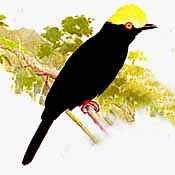 |
In African Silences, Peter Matthiessen tells of asking famous African ornithologists about the "best birds" in Africa. Most agreed on the 2 rockfowl, Congo Peafowl & Shoebill, but this little known species, confined to mountains in e. Dem. Rep. of Congo (previously Zaire), was a surprising next choice by some. Surprising, perhaps, since it is hard to reach its habitat, but it is striking rare. Recent surveys in the Itombwe Mts. have found a few but very little is known of it. |
No |
18 |
any Cassowary
Casuarius sp.
[Australasia] |
|
An observer can spend weeks in forests inhabited by cassowaries but never see one. These powerful but flightless birds are exceptionally elusive. A sighting of any of the 3 species is a major highlight: Southern C. casuarius [ne. Australia, s. New Guinea], Northern C. unappendiculatus [w. New Guinea] or Dwarf C. bennetti [foothills of e. New Guinea]. For more, see my "Cassowary' page. |
Yes;
2 of 3 |
19 |
any Kiwi
Apteryx sp.
[New Zealand] |
|
It is absolutely wonderful to see any of the 5 species of kiwi. Brown Kiwi is now split into three — North Island Brown Apteryx mantelli, Okarito Brown A. rowi, and Southern Brown A. australis — but everywhere a kiwi is elusive and mostly declining. Little Spotted A. owenii & Great Spotted A. haastii have limited ranges. These are nocturnal enigmas that probe for earthworms; females lay unbelievably large eggs for their body size. Totally unique, they behave like mammals in many ways. |
Yes;
1 of 5 |
20 |
Long-tailed Ground-Roller
Uratelornis chimaera
[sw. Madagascar] |
|
Of all the great birds in Madagascar, this is the one that captured my imagination 45 years ago. It is the strangest of this Malagasy endemic family: a unique mix of a roadrunner, pitta & roller. It is the headline species of the unworldly spiny desert. Gnerally found it pairs, it is still rare and can be elusive. It is one of those cool, cocky birds that have personality. |
Yes |


